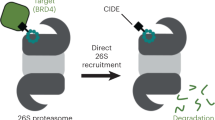Abstract
The ubiquitin-proteasome pathway is the central mediator of regulated proteolysis in cells, and defects in this pathway are associated with cancer and neurodegenerative diseases. To assess 26S proteasome function in living animals, we developed a ubiquitin-luciferase reporter for bioluminescence imaging. The reporter was degraded rapidly under steady-state conditions and stabilized in a dose- and time-dependent manner in response to proteasome inhibitors. Using bioluminescence imaging after one dose of the chemo-therapeutic proteasome inhibitor bortezomib (PS-341), proteasome function in tumor xenografts was blocked within 30 min and returned to nearly baseline by 46 h. After a 2-week regimen of bortezomib, however, imaging of target tumors showed significantly enhanced proteasome inhibition that no longer returned to baseline. The ubiquitin-luciferase reporter enables repetitive tissue-specific analysis of 26S proteasome activity in vivo and should facilitate development and validation of proteasome inhibitors in mouse models, as well as investigations of the ubiquitin-proteasome pathway in disease pathogenesis.
This is a preview of subscription content, access via your institution
Access options





Similar content being viewed by others
References
Sakamoto, K. Ubiquitin-dependent proteolysis: its role in human diseases and the design of therapeutic strategies. Mol. Genet. Metab. 77, 44–56 (2002).
Glickman, M. & Ciechanover, A. The ubiquitin-proteasome proteolytic pathway: destruction for the sake of construction. Physiol. Rev. 82, 373–428 (2002).
Pye, J. et al. Proteasome inhibition ablates activation of NF-κB induced during myocardial reperfusion and reduces reperfusion injury. Am. J. Physiol. Heart Circ. Physiol. 284, H919–H926 (2002).
Zhang, L. et al. Postischemic (6-hour) treatment with recombinant human tissue plasminogen activator and proteasome inhibitor PS-519 reduces infarction in a rat model of embolic focal cerebral ischemia. Stroke 32, 2926–2931 (2001).
Adams, J. Proteasome inhibitors as new anticancer drugs. Curr. Opin. Oncol. 14, 628–634 (2002).
Hideshima, T. & Anderson, K. Molecular mechanisms of novel therapeutic approaches for multiple myeloma. Nat. Rev. Cancer 2, 927–937 (2002).
Voges, D., Zwickl, P. & Baumeister, W. The 26S proteasome: a molecular machine designed for controlled proteolysis. Annu. Rev. Biochem. 68, 1015–1068 (1999).
Navon, A. & Goldberg, A. Proteins are unfolded on the surface of the ATPase ring before transport into the proteasome. Mol. Cell 8, 1339–1349 (2001).
Leggett, D. et al. Multiple associated proteins regulate proteasome structure and function. Mol. Cell 10, 495–507 (2002).
Lightcap, E. et al. Proteasome inhibition measurements: clinical application. Clin. Chem. 46, 673–683 (2000).
Stack, J., Whitney, M., Rodems, S. & Pollok, B. A ubiquitin-based tagging system for controlled modulation of protein stability. Nat. Biotechnol. 18, 1298–1302 (2000).
Kang, Z., Pirskanen, A., Janne, O. & Palvimo, J. Involvement of proteasome in the dynamic assembly of the androgen receptor transcription complex. J. Biol. Chem. 277, 48366–48371 (2002).
Deroo, B. & Archer, T. Proteasome inhibitors reduce luciferase and beta-galactosidase activity in tissue culture cells. J. Biol. Chem. 277, 20120–20123 (2002).
Kisselev, A. & Goldberg, A. Proteasome inhibitors: from research tools to drug candidates. Chem. Biol. 8, 739–758 (2001).
Lin, G. et al. Crystal structure of calcium bound domain VI of calpain at 1.9 Å resolution and its role in enzyme assembly, regulation, and inhibitor binding. Nat. Struct. Biol. 4, 539–547 (1997).
Welsh, S. & Kay, S. Reporter gene expression for monitoring gene transfer. Curr. Opin. Biotechnol. 8, 617–622 (1997).
Dantuma, N., Lindsten, K., Glas, R., Jeline, M. & Masucci, M. Short-lived green fluorescent proteins for quantifying ubiquitin/proteasome-dependent proteolysis in living cells. Nat. Biotechnol. 18, 538–543 (2000).
LeBlanc, R. et al. Proteasome inhibitor PS-341 inhibits human myeloma cell growth in vivo and prolongs survival in a murine model. Cancer Res. 62, 4996–5000 (2002).
Adams, J. Proteasome inhibition: a novel approach to cancer therapy. Trends Mol. Med. 8, S49–S54 (2002).
Orlowski, R. et al. Phase I trial of the proteasome inhibitor PS-341 in patients with refractory hematologic malignancies. J. Clin. Oncol. 20, 4420–4427 (2002).
Johnson, E., Bartel, B., Seufert, W. & Varshavsky, A. Ubiquitin as a degradation signal. EMBO J. 11, 497–505 (1992).
Bence, N., Sampat, R. & Kopito, R. Impairment of the ubiquitin-proteasome system by protein aggregation. Science 292, 1552–1555 (2001).
Acknowledgements
This work was funded by National Institutes of Health grant P50 CA94056.
Author information
Authors and Affiliations
Corresponding author
Ethics declarations
Competing interests
The authors declare no competing financial interests.
Rights and permissions
About this article
Cite this article
Luker, G., Pica, C., Song, J. et al. Imaging 26S proteasome activity and inhibition in living mice. Nat Med 9, 969–973 (2003). https://doi.org/10.1038/nm894
Received:
Accepted:
Published:
Issue Date:
DOI: https://doi.org/10.1038/nm894
This article is cited by
-
Effects of iron modulation on mesenchymal stem cell-induced drug resistance in estrogen receptor-positive breast cancer
Oncogene (2022)
-
Tyropeptins, proteasome inhibitors produced by Kitasatospora sp. MK993-dF2
The Journal of Antibiotics (2017)
-
Proteasome properties of hemocytes differ between the whiteleg shrimp Penaeus vannamei and the brown shrimp Crangon crangon (Crustacea, Decapoda)
Cell Stress and Chaperones (2017)
-
Endothelial CXCR7 regulates breast cancer metastasis
Oncogene (2016)
-
Proteasomal inhibition sensitizes cervical cancer cells to mitomycin C-induced bystander effect: the role of tumor microenvironment
Cell Death & Disease (2015)



